


Terborgh and his colleagues concluded that “the presence of a viable carnivore guild is fundamental to maintaining biodiversity”. Within seven years, 75% of the remaining vertebrate species had disappeared. On those islands that were too small to sustain predators (i.e., cougars, jaguars and Harpy eagles), herbivore populations increased dramatically and overran the islands, leading to the reproductive failure of vegetation and a rapid decline in overall biodiversity. One of the most vivid illustrations of the ecological changes wrought by the disappearance of cougars and large carnivores comes from research by ecologist John Terborgh and his colleagues on newly-formed forested islands created by a large scale water impoundment in Venezuela. They also influence competitive interactions between herbivores. A powerful selective force on prey, cougars can regulate the size of ungulate populations such as deer and elk and thus indirectly affect the impacts of ungulates on plant communities. Through their interactions with prey, cougar influence energy flow in ecosystems and thus influence the structure and function of ecosystems. The cougar’s extensive distribution throughout the Americas, its adaptability to a wide array of habitats, and its superior predatory ability may afford it a more important ecological role than any other top carnivore in the western hemisphere.


 0 kommentar(er)
0 kommentar(er)
